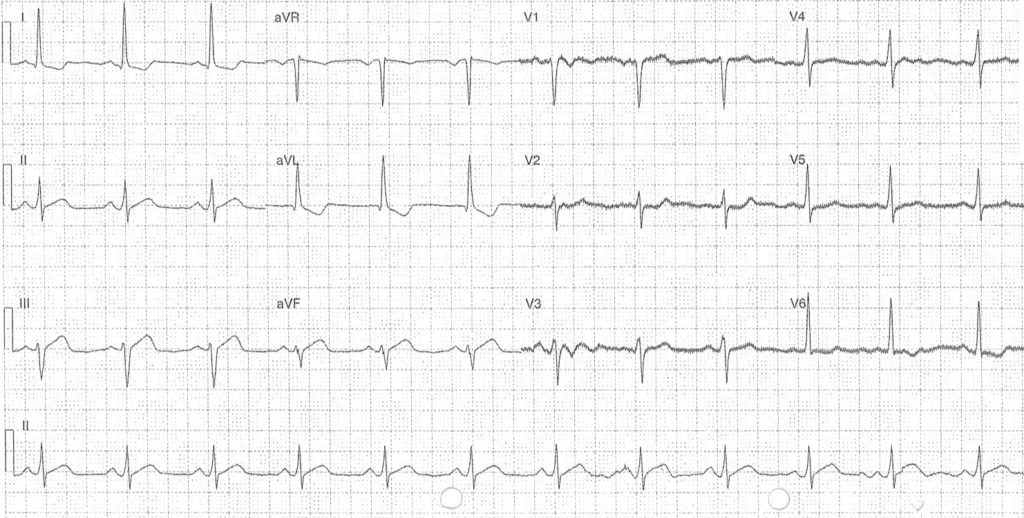The following ECG is from a 55 year old male who presented to the ED after experiencing on-going left sided chest ache.

Interpretation
- Describe the key features of this ECG.
- How would you manage this patient?
- He is taken to the Angio suite on site. In which vessel would you expect to find disease?
Interpretation:
- Rate: 72 bpm
- Rhythm: Regular and sinus
- Axis: Normal
- Intervals:
PR 160
QRS 100
- Morphology:
STE: 1mm III, aVF; Reciprocal changes: 1, aVL; STD 1mm also seen in V6
- Summary: Inferior STEMI
Clinical correlation:
- Control pain – IV analgesia, no GTN for this patient (risk of RV involvement)
- Anticoagulation – Aspirin 300mg, Ticagrelor 180mg, Heparin 5000U
- PCI – found to have proximal occlusion of RCA
Some More Info re Criteria for JHC Code STEMI:
as per JEDO guidelines: Adult: Chest Pain: Code STEMI
http://jhced.org/wp-content/uploads/Joondalup-Health-Campus-STEMI-PCI-draft-protocol-Aug2017-1.pdf
Why Does The ECG Change in AMI?
AMI Affects both
- Ventricular depolarisation = pathological Q waves (being >40ms, deeper than 1/3 height QRS)
- Ventricular repolarisation = ST and T wave changes
- Specific changes are proportional to the type of lesion:
- Subendocardial = STD or NSTEMI
- Transmural = STE or STEMI
For brilliant doodles of the heart, its anatomy and its relevance to ECG leads take a look at this post from Life in The Fast Lane to correlate anatomical disease with ECG changes
For those of you that like a good table here is a summary of the above:
| Location | Vessels | ST Change | Reciprocal Change |
Associations |
| Antr MI | LAD | V1-4, V5-6 | None | Heart failure/ hypotension Ventricular Septal Rupture |
| Lat MI | LCx MO |
I, aVL, V5, V6 | II, III, aVF | |
| Infr MI | RCA (80%) RCX (20%) |
II, III, aVF | I, AVL | AV Block RCA – papillary muscle rupture (MR) |
| Postr MI | RCx | V7, V8, V9 | V1, V2, V3 (inc tall R waves, STD >2mm) |
Rare in isolation Often involve inf. or lat. wall |
| Septal MI | LAD septal branches |
V1-4 Lack of Q in V5, V6 |
None | |
| RV MI | RCA | V1, V4R | I, aVL |
And finally for a ‘look at the ECG and see the vessel approach‘ this deranged physiology page has you covered.
Further Reading:
http://www.medicine-on-line.com/html/ecg/e0001en_files/14.htm
https://ecgwaves.com/stemi-st-elevation-myocardial-infarction-criteria-ecg/
with thanks to the linked Pages….
and of course……A massive THANK YOU to John Larkin, without whom this ECG forum would not exist. We hope to do you justice whilst revisiting some of the basics for new registrars in the department. Good luck in your future teaching ventures!
